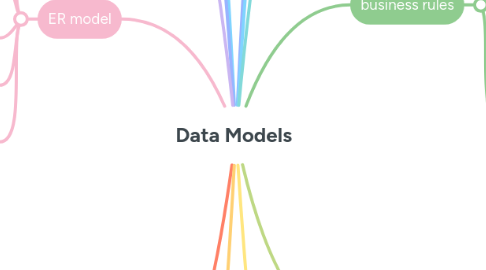
1. hierarchical models
1.1. developed to manage large amounts of data
1.2. represented by upside-down tree contains segments
1.3. a set of 1:M relationships
2. network models
2.1. created to represent complex data relationships effectively
2.2. improve database performance
2.3. allows a record to have more than one parent
3. RDBMS
3.1. performs basic functions provided by hierarchical and network DBMC systems
3.2. makes relational data model easier to understand and implement
3.3. hides complexities of relational model from users
4. ER model
4.1. graphical representation of entities and their relationships in database structure
4.2. ERD
4.2.1. uses graphic representations to model database components
4.3. entity instance
4.3.1. rows in relational table
4.4. attributes
4.4.1. describe particular characteristics
4.5. connectivity
4.5.1. term used to label the relationship types
5. Object-oriented data model
5.1. data and its relationships are contained in a single structure known as an object
5.1.1. OODBMS
5.2. object
5.2.1. contains data and their relationships with operations that are performed on it
5.3. attribute
5.3.1. describes the properties of an object
5.4. class
5.4.1. collection of similar objects with shared structure and behaviour
5.5. class hierarchy
5.5.1. resembles an upside-down tree;each class has one parent
5.6. inheritance
5.6.1. object inherits methods and attributes of classes above it
5.7. UML
5.7.1. describes sets of diagrams and symbols to graphically model a system
6. NoSQL
6.1. high scalability
6.2. support large amounts of sparse data
6.3. types
6.3.1. key-value
6.3.2. column family
6.3.3. document
6.3.4. graph
7. data modelling
7.1. creating specififc data model for a determined problem domain
7.1.1. Data model:simple representation of complex real-world data structures
7.1.2. Model: abstraction of a more complex real-world object or event
8. importance of data modeling
8.1. facilitates communication
8.2. gives various views of database
8.3. organizes data for various users
8.4. provides abstraction for the creation of good database
9. basic building blocks
9.1. entity
9.2. attribute
9.3. relationship
9.4. constraint
9.4.1. ensure data integrity
10. business rules
10.1. source
10.1.1. company managers
10.1.2. policy makers
10.1.3. department managers
10.1.4. written documentation
10.1.5. direct interviews with end users
10.2. reasons for identifying and documenting
10.2.1. standardize company's view of data
10.2.2. facilitate communications tool between users and designers
10.2.3. assist designers
11. naming conventions
11.1. entity
11.1.1. descriptive
11.1.2. use terminology that is familiar to users
11.2. attribute
11.2.1. descriptive
11.3. proper naming
11.3.1. promotes self-documentation
12. big data
12.1. goals
12.1.1. find new and better ways to manage large amounts of web and sensor-generated data
12.1.2. provide high performance at a reasonable cost
12.2. characteristics
12.2.1. volume
12.2.2. velocity
12.2.3. variety
12.3. challenges
12.3.1. expensive
12.3.2. OLAP tools proved inconsistent in dealing with unstructured data
12.4. new tech
12.4.1. Hadoop
12.4.2. Hadoop distributed file system(HDFS)
12.4.3. MapReduce
12.4.4. NoSQL
